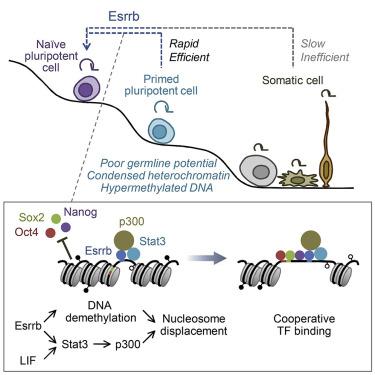当前位置:
X-MOL 学术
›
Cell Stem Cell
›
论文详情
Our official English website, www.x-mol.net, welcomes your feedback! (Note: you will need to create a separate account there.)
Esrrb Unlocks Silenced Enhancers for Reprogramming to Naive Pluripotency.
Cell Stem Cell ( IF 23.9 ) Pub Date : 2018-Aug-02 , DOI: 10.1016/j.stem.2018.05.020 Kenjiro Adachi , Wolfgang Kopp , Guangming Wu , Sandra Heising , Boris Greber , Martin Stehling , Marcos J. Araúzo-Bravo , Stefan T. Boerno , Bernd Timmermann , Martin Vingron , Hans R. Schöler
Cell Stem Cell ( IF 23.9 ) Pub Date : 2018-Aug-02 , DOI: 10.1016/j.stem.2018.05.020 Kenjiro Adachi , Wolfgang Kopp , Guangming Wu , Sandra Heising , Boris Greber , Martin Stehling , Marcos J. Araúzo-Bravo , Stefan T. Boerno , Bernd Timmermann , Martin Vingron , Hans R. Schöler

|
Transcription factor (TF)-mediated reprogramming to pluripotency is a slow and inefficient process, because most pluripotency TFs fail to access relevant target sites in a refractory chromatin environment. It is still unclear how TFs actually orchestrate the opening of repressive chromatin during the long latency period of reprogramming. Here, we show that the orphan nuclear receptor Esrrb plays a pioneering role in recruiting the core pluripotency factors Oct4, Sox2, and Nanog to inactive enhancers in closed chromatin during the reprogramming of epiblast stem cells. Esrrb binds to silenced enhancers containing stable nucleosomes and hypermethylated DNA, which are inaccessible to the core factors. Esrrb binding is accompanied by local loss of DNA methylation, LIF-dependent engagement of p300, and nucleosome displacement, leading to the recruitment of core factors within approximately 2 days. These results suggest that TFs can drive rapid remodeling of the local chromatin structure, highlighting the remarkable plasticity of stable epigenetic information.
中文翻译:

Esrrb解锁沉默的增强子,以重新编程为幼稚的多能性。
转录因子(TF)介导的多能性重编程是一个缓慢且效率低下的过程,因为大多数多能性TF无法访问难治性染色质环境中的相关目标位点。尚不清楚在长时间的重编程过程中,TF如何真正协调抑制性染色质的开放。在这里,我们表明,孤儿核受体Esrrb在表皮干细胞重编程过程中,将核心多能性因子Oct4,Sox2和Nanog募集到封闭染色质的失活增强子中发挥了开创性作用。Esrrb与沉默的增强子结合,而沉默的增强子包含稳定的核小体和高甲基化的DNA,这是核心因子无法获得的。Esrrb结合会伴随DNA甲基化的局部丢失,p300的LIF依赖性结合以及核小体置换,导致在大约2天内招募核心因素。这些结果表明,TFs可以驱动局部染色质结构的快速重塑,突出了稳定表观遗传信息的显着可塑性。
更新日期:2018-06-14
中文翻译:

Esrrb解锁沉默的增强子,以重新编程为幼稚的多能性。
转录因子(TF)介导的多能性重编程是一个缓慢且效率低下的过程,因为大多数多能性TF无法访问难治性染色质环境中的相关目标位点。尚不清楚在长时间的重编程过程中,TF如何真正协调抑制性染色质的开放。在这里,我们表明,孤儿核受体Esrrb在表皮干细胞重编程过程中,将核心多能性因子Oct4,Sox2和Nanog募集到封闭染色质的失活增强子中发挥了开创性作用。Esrrb与沉默的增强子结合,而沉默的增强子包含稳定的核小体和高甲基化的DNA,这是核心因子无法获得的。Esrrb结合会伴随DNA甲基化的局部丢失,p300的LIF依赖性结合以及核小体置换,导致在大约2天内招募核心因素。这些结果表明,TFs可以驱动局部染色质结构的快速重塑,突出了稳定表观遗传信息的显着可塑性。


























 京公网安备 11010802027423号
京公网安备 11010802027423号